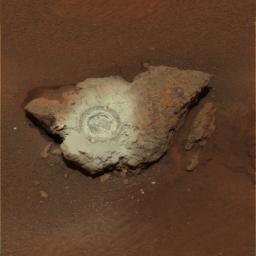
|
‘Bounce’ Exposed
- Click the image above for a larger view
- Full-Res JPEG (1024 x 1024) (118.2 kB)
- Full-Res TIFF (1024 x 1024) (2.9 MB)
Caption:
April 14, 2004
Bringing Out the Color in 'Bounce'
This false-color composite of the rock dubbed "Bounce" shows the rock
after the Mars Exploration Rover Opportunity drilled into it with its rock
abrasion tool.
The drilling of the 7-millimeter-deep (0.3-inch) hole generated a bright powder. The color in this image has been enhanced to show that these tailings are relatively blue when compared with the unaltered rock (to the human eye, the tailings would appear red).
This image was assembled from the infrared (750-nanometer),green (530-nanometer) and violet (430-nanometer) filters of the rover's panoramic camera. It was taken on sol 68.

Figure 1: The Many Sides of 'Bounce'
In Figure 1, the graph shows light signatures, or spectra, taken from five different places on the rock dubbed "Bounce" at Meridiani Planum. The green and yellow spectra are from the bright rock powder and dark rock surface respectively. These spectra show a drop in reflectance near the one-micron wavelength mark, consistent with a less-oxidized, iron-bearing silicate such as olivine or pyroxene. These findings are not inconsistent with this rock being a basaltic rock. The relative brightness of the powder can be explained by particle sizes.
The red spectrum is from the bright dusty soil next to Bounce. The spectrum is dominated by the signature of oxidized "ferric" iron (Fe3+) like that seen in the classic martian dust. The teal spectrum is from the darker Meridiani soils. That spectrum is also dominated by ferric iron, though the reflectivity is lower probably because the grains are coarser in these soils compared to the dust.
The purple spectrum from the larger granules in the Meridiani soil show a fine-grained iron oxide (Fe3+) component. These spectra were taken by the rover's panoramic camera.

Figure 2: 'Bounce' Gets a Thorough Read
This image shows the rock dubbed "Bounce" near the Mars Exploration Rover Opportunity's landing site at Meridiani Planum, Mars. The two colored spots show where scientists took measurements of the rock with the rover's miniature thermal emission spectrometer. The area on the right is untouched rock and the area on the left is where the rover drilled a hole. This image was taken by the rover's panoramic camera.
Cataloging Keywords:
| Name | Value | Additional Values |
|---|---|---|
| Target | Mars | |
| System | ||
| Target Type | Planet | |
| Mission | Mars Exploration Rover (MER) | |
| Instrument Host | Opportunity (MER-B) | |
| Host Type | Rover | |
| Instrument | Panoramic Camera (Pancam) | |
| Detector | ||
| Extra Keywords | Atmosphere, Color, Dust, Infrared, Storm, Thermal | |
| Acquisition Date | ||
| Release Date | 2004-04-09 | |
| Date in Caption | 2004-04-14 | |
| Image Credit | NASA/JPL/Cornell | |
| Source | photojournal.jpl.nasa.gov/catalog/PIA05731 | |
| Identifier | PIA05731 | |
